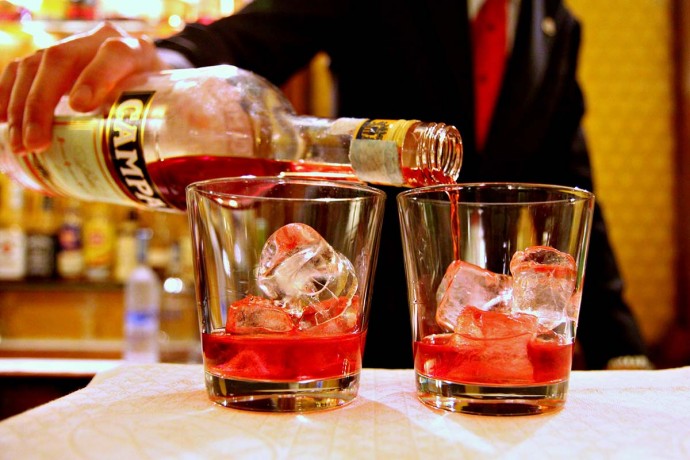While it has only recently become cocktail royalty alongside the Old-Fashioned, Martini, and Manhattan, the Negroni is certainly a classic. Gin, sweet vermouth, and Campari in equal parts make this one of the simplest recipes of the pantheon, and, frankly, one of the hardest to screw up. But despite its popularity, it wasn’t until the last few decades that anyone really agreed on how the drink came to be. The tireless work of cocktail gurus David Wondrich and Gary “Gaz” Regan have revealed the history of the Negroni to be a tale of family name disputes and, of course, a hard-drinking Italian cowboy.
The Ancestors
Seasoned cocktail drinkers will probably have noticed some similarities between the Negroni and another Italian classic, the Americano. Rising to popularity during and after the First World War, this is a similarly uncomplicated drink that consists of Campari, sweet vermouth, and soda water. It doesn’t pack much of a punch, but it’s one of the earliest indications that at least two of the Negroni’s ingredients were destined to end up in the same glass.
According to Gaz Regan, in his excellent book The Negroni, the Americano was itself a variation of two other Italian cocktails: the Milano-Torino, made with Campari and Martini Rosso sweet vermouth, and the Torino-Milano, a mixture of Campari and Amaro Cora. We’ve had a bit of trouble keeping the names straight, but both are worth a try if you’re a fan of Italian potable bitters (and annoying your bartender with arcane drink orders).
The Two Counts Negroni
As with any cocktail, the central figure of the Negroni’s history is the person who first decided to mix one up. It shouldn’t be surprising that, when it comes to such an iconic recipe, the identity of that legendary drinker has been a matter of some debate. What is generally agreed upon is that, at some point, a man named Count Negroni asked his bartender to replace the soda in an Americano with gin. The trouble is, there were two people who went by that name, and both claimed to have done so first.
We’ll start with the candidate whose story doesn’t quite hold up under scrutiny. General Pascal Olivier Count de Negroni, born in 1829, was an illustrious brigadier general in the French army who was best known for his heroics in the Franco-Prussian War. He led a long career that garnered decorations from the Emperor Napoleon himself, and according to a few of his descendants, included a brief pit-stop to invent one of the world’s most famous cocktails. Unfortunately for the general’s supporters, though, it’s unlikely that he could have done so. Pascal Olivier died in 1913, but sources indicate that the Negroni didn’t start to appear in Italian bars until at least 1919.
The most widely accepted story among cocktail historians is, strangely, a much more outlandish one. Count Camillo Luigi Manfredo Maria Negroni, born in Florence in 1868, was something of a legend of the American west. He made his way from Italy to the States in the late 1880s and proceeded to make a living as a rodeo cowboy for nearly fifteen years, earning a reputation as a man who knew how to gamble and party with the best of them.
A 1928 account from a journalist at the Spokane Chronicle, shared in Regan’s book by way of David Wondrich, details a chance encounter with Count Camillo Negroni in the Italian countryside which simply demands to be quoted here. The count, astride his horse, told the reporter that while in the States he “learned enough about stud, keno, and faro to get broke and stay that way. Punching horses suited me to death and I went adventuring over the ranges … I roughed it plenty; rode herd up through the Yellowstone country and wound up in the province of Alberta, Canada, horning in at the Oxley ranch.”
The rest of the story—not discussed in the Chronicle piece—tells that after making his way back to Florence in 1905, Negroni found himself in his favorite bar, Cafè Casoni. There, he ordered an Americano from bartender Fosco Scarselli, famously requesting the substitution of gin. Whether or not it actually occurred that way is, of course, nearly impossible to verify, but there exists enough evidence for most cocktail historians to agree that Camillo has the strongest claim to the recipe. The issue is far from resolved, though. A quick glance at the discussion on Wikipedia’s Negroni page will show you just how passionate some people are about their drinks.
Post-War Popularity
The enemy of the Negroni’s growth in the United States was, as we’ve come to expect, Prohibition. First appearing on the eve of the Volstead Act’s passage, it would be more than twenty years before Americans came to appreciate this Italian original. In the 1940s, it began to appear once again in newspapers and cocktail bars across the country, but the drink was often overshadowed by more well-known recipes like the Martini and Manhattan. The turn of the twentieth century saw the renaissance of the craft cocktail, and though it has taken a while to gain its contemporary status as a classic, the Negroni now stands tall as a member of the canon.
Regardless of who came up with the recipe, we can all agree that the Negroni deserves its reputation as one of the greats. The ingredients blend so perfectly that their combination almost seems predestined—a holy trinity of gin, vermouth, and Campari that can be tweaked and adjusted to match any palate. Perhaps it’s fitting that we may never know the story of its origin with any certainty. The mystery is half the fun.
Photo: Franz Conde on Flickr



